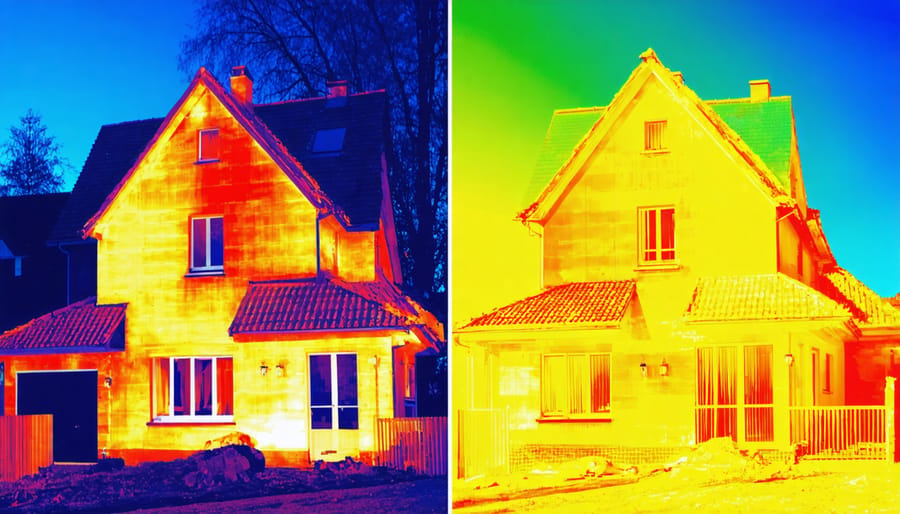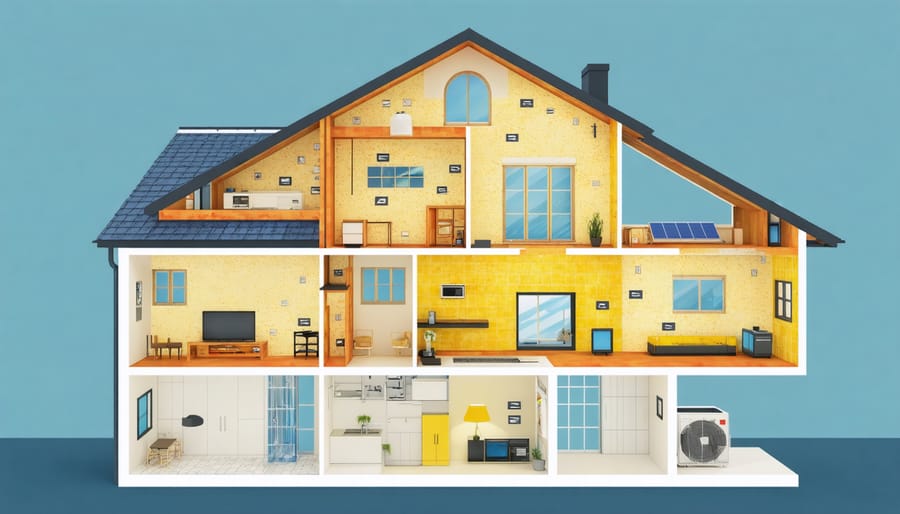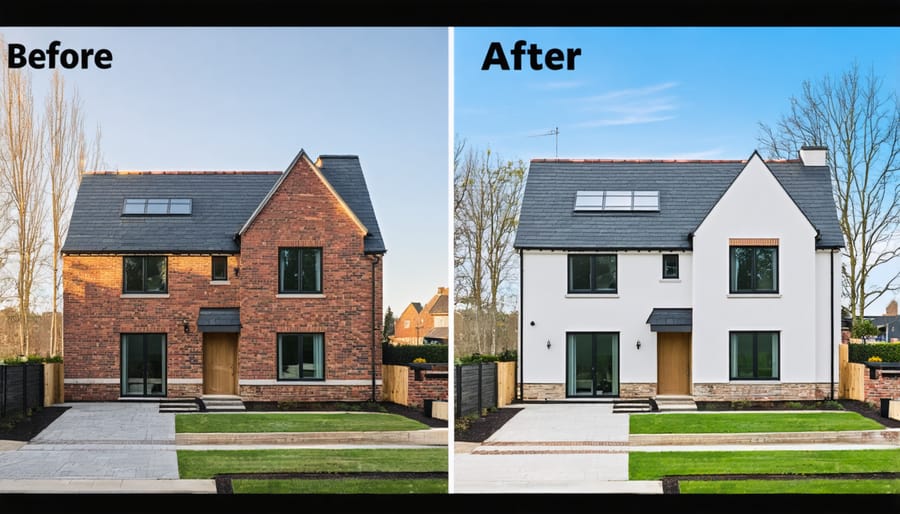Deep energy retrofits represent a transformative approach to building modernization, cutting energy consumption by up to 75% while dramatically improving occupant comfort and property value. These comprehensive renovations go far beyond traditional weatherization, targeting the building envelope, HVAC systems, and energy management infrastructure simultaneously. As climate change accelerates and energy costs continue to rise, deep retrofits have emerged as a crucial strategy for both commercial and residential property owners seeking long-term sustainability and financial returns.
Industry leaders increasingly recognize deep energy retrofits as essential investments rather than optional upgrades. The process typically combines advanced building diagnostics, state-of-the-art insulation techniques, and intelligent energy systems to create high-performance buildings that meet or exceed modern efficiency standards. With federal incentives and rebate programs now available, property owners can often recover their investment within 5-10 years while contributing to significant carbon reduction goals.
Success stories from early adopters demonstrate the potential: A 1960s office building in Boston reduced its energy consumption by 68% after a deep retrofit, while a multi-family complex in Chicago cut utility costs by $375,000 annually. These results underscore why deep energy retrofits are becoming the new standard for building modernization in an era of climate action and rising operational costs.
Understanding Deep Energy Retrofits

Key Components of Deep Energy Retrofits
Deep energy retrofits encompass several critical components that work together to maximize energy efficiency and building performance. The foundation of any successful retrofit begins with comprehensive insulation upgrades. This includes installing high-performance insulation in walls, attics, and foundations, often utilizing materials like spray foam, cellulose, or mineral wool to achieve optimal R-values.
HVAC system modernization represents another crucial element, typically involving the replacement of outdated heating and cooling equipment with high-efficiency alternatives. This might include installing heat pumps, advanced temperature controls, and energy recovery ventilators to maintain indoor air quality while minimizing energy loss.
Window replacements play a vital role in reducing heat transfer and improving comfort. Triple-pane windows with low-E coatings and insulated frames can dramatically reduce energy loss compared to older single-pane windows. Strategic window placement and sizing can also optimize natural lighting and passive solar heating.
Air sealing stands as perhaps the most cost-effective component of deep energy retrofits. This involves identifying and sealing air leaks throughout the building envelope using appropriate materials and techniques. Common areas requiring attention include wall-roof connections, utility penetrations, and door frames.
Building automation systems often complete the retrofit package, allowing for intelligent control of heating, cooling, and ventilation based on occupancy patterns and environmental conditions. These systems help maintain optimal performance and ensure the various components work together efficiently.
Benefits Beyond Energy Savings
Deep energy retrofits deliver substantial benefits beyond mere energy savings. Occupants experience enhanced thermal comfort through improved insulation and air sealing, eliminating drafts and temperature fluctuations. Indoor air quality significantly improves with modern ventilation systems and moisture control measures, creating healthier living and working environments.
Property values typically increase following comprehensive retrofits, with energy-efficient buildings commanding premium prices in the real estate market. Building durability also improves through better moisture management and structural upgrades, extending the facility’s lifespan. Additionally, retrofitted buildings often provide better acoustic isolation, reducing noise pollution from external sources.
These improvements contribute to increased occupant productivity in commercial settings and greater comfort in residential buildings, while simultaneously demonstrating environmental leadership and corporate responsibility. For many organizations, these ancillary benefits prove as valuable as the energy cost savings themselves.

Essential Retrofit Technologies
Advanced Insulation Systems
Modern insulation technologies have revolutionized deep energy retrofits, offering superior thermal performance and enhanced building envelope protection. High-performance materials like aerogel-based products provide exceptional R-values while maintaining minimal thickness, making them ideal for space-constrained retrofits. Vacuum Insulated Panels (VIPs) deliver up to five times the insulation value of traditional materials, though they require careful handling during installation.
Closed-cell spray foam insulation creates an effective air barrier while providing excellent thermal resistance, particularly suitable for irregular spaces and hard-to-reach areas. Advanced mineral wool products offer improved fire resistance and sound dampening properties alongside their thermal benefits. Multi-layer reflective insulation systems combine multiple technologies to achieve optimal performance in varying climate conditions.
These advanced solutions often integrate smart vapor barriers and moisture management systems, ensuring long-term building durability. While initial costs may be higher than conventional materials, these systems typically deliver superior ROI through enhanced energy savings and reduced maintenance requirements. Modern installation techniques, including precision application methods and quality control measures, ensure maximum system effectiveness and longevity.
High-Performance Windows and Doors
High-performance windows and doors are crucial components of any deep energy retrofit, typically accounting for 25-30% of a building’s heat loss when not properly optimized. Modern fenestration solutions incorporate advanced technologies such as triple-pane glazing, low-emissivity (Low-E) coatings, and thermally broken frames to achieve U-values as low as 0.15.
These upgraded components feature argon or krypton gas fills between panes to reduce heat transfer, while warm-edge spacers minimize thermal bridging around the perimeter. Quality installation is paramount, with proper air sealing and flashing details essential for optimal performance.
When selecting windows and doors, look for ENERGY STAR certification and National Fenestration Rating Council (NFRC) labels, which provide verified performance metrics. Premium options may include dynamic glazing that adjusts tint levels automatically based on sunlight intensity or electrochromic glass that can be controlled manually.
While high-performance windows and doors represent a significant upfront investment, they typically deliver 15-25% energy savings on heating and cooling costs. Additional benefits include improved thermal comfort, reduced condensation, and enhanced sound insulation, making them a cornerstone of successful deep energy retrofits.
Smart HVAC Solutions
Modern HVAC systems represent a cornerstone of deep energy retrofits, offering unprecedented control over building climate while significantly reducing energy consumption. Implementation of smart HVAC retrofits can achieve energy savings of 30-50% compared to conventional systems through advanced technologies and intelligent controls.
Key components include variable-speed heat pumps, which adjust output based on real-time demand, and smart zoning systems that optimize temperature control for different areas independently. Advanced building automation systems (BAS) integrate with occupancy sensors and weather forecasting to predictively manage heating and cooling cycles.
Energy recovery ventilators (ERVs) play a crucial role by transferring heat and moisture between incoming and outgoing air streams, maintaining indoor air quality while minimizing energy loss. Modern HVAC solutions also incorporate sophisticated filtration systems and UV-C sanitization technology, addressing both energy efficiency and indoor air quality concerns.
These systems typically feature remote monitoring capabilities, allowing facility managers to track performance metrics and adjust settings in real-time through cloud-based platforms, ensuring optimal operation and proactive maintenance scheduling.
Renewable Energy Integration
Integrating renewable energy sources is a crucial component of deep energy retrofits, maximizing both sustainability and cost-effectiveness. Solar photovoltaic systems, when combined with smart energy management systems, create a synergistic effect that optimizes building performance. These systems work together to reduce grid dependency while ensuring consistent energy supply throughout varying weather conditions and peak usage periods.
To enhance the benefits of solar integration, many facility managers incorporate home battery storage solutions, allowing excess energy to be stored for later use. This approach particularly complements other retrofit measures such as improved insulation and efficient HVAC systems, creating a comprehensive energy management strategy.
Recent case studies demonstrate that buildings implementing combined solar and retrofit solutions achieve 60-80% greater energy savings compared to traditional retrofits alone. The integration of renewable technologies also provides additional benefits, including increased property value, enhanced energy security, and qualification for various government incentives and sustainability certifications.
Implementation and Cost Considerations
Planning Your Retrofit Project
A successful deep energy retrofit begins with comprehensive planning and assessment. Start by conducting a thorough building energy audit to identify current energy consumption patterns, structural conditions, and potential improvement areas. This baseline assessment should include analyzing utility bills, performing blower door tests, and evaluating existing insulation and HVAC systems.
Next, establish clear project goals and priorities. Define specific energy reduction targets, comfort improvements, and budget constraints. Consider factors such as building occupancy patterns, local climate conditions, and future maintenance requirements when setting these objectives.
Develop a detailed scope of work by consulting with qualified energy professionals and contractors. This should outline specific improvements such as building envelope upgrades, mechanical system replacements, and renewable energy installations. Create a logical sequencing plan to ensure interventions are implemented in the most effective order.
Financial planning is crucial for project success. Research available incentives, rebates, and financing options. Calculate projected energy savings and return on investment to build a compelling business case. Consider phasing the retrofit if budget constraints exist, but ensure each phase aligns with the overall project goals.
Finally, establish a project timeline that accounts for material procurement, contractor availability, and potential disruptions to building operations. Include contingency plans for unexpected challenges and establish clear communication channels with all stakeholders. Regular progress monitoring and quality control measures should be incorporated into the planning framework to ensure desired outcomes are achieved.
Financial Analysis and ROI
Deep energy retrofits represent a significant investment, but their long-term financial benefits often justify the initial costs. A comprehensive retrofit typically costs between $25,000 and $50,000 for single-family homes, with commercial properties ranging from $15-30 per square foot. However, these projects can reduce energy consumption by 40-60% on average, translating to substantial operational savings.
The ROI timeline for deep energy retrofits generally spans 7-15 years, depending on factors such as existing building conditions, energy rates, and the scope of improvements. Property owners can accelerate their return through various energy-efficient financing options and incentives, including federal tax credits, state rebates, and utility company programs.
Recent case studies demonstrate impressive financial outcomes. A 50,000-square-foot office building in Boston achieved annual energy savings of $115,000 after a $1.2 million retrofit, while a multi-family residential complex in Chicago reduced utility costs by 45% following a $750,000 investment. These projects also benefited from increased property values, with retrofitted buildings commanding 7-10% higher market prices.
Available incentives can significantly offset initial costs. The Federal 179D tax deduction offers up to $1.88 per square foot for qualifying commercial buildings, while many states provide additional incentives. Some utility companies offer custom rebate programs covering up to 50% of project costs for verified energy savings.
When calculating ROI, it’s essential to consider non-energy benefits such as improved occupant comfort, reduced maintenance costs, and enhanced property marketability. These factors often accelerate the payback period and increase the overall return on investment. Additionally, as energy costs continue to rise and carbon regulations become stricter, the financial advantages of deep energy retrofits become increasingly compelling for forward-thinking property owners and investors.

Case Study: Successful Deep Energy Retrofit
A 1920s Colonial-style home in Massachusetts demonstrates the transformative potential of deep energy retrofits. The 2,800-square-foot residence underwent a comprehensive renovation in 2019, resulting in a 78% reduction in annual energy consumption and significant improvements in comfort and indoor air quality.
The project began with a thorough energy audit that identified major thermal envelope deficiencies and outdated mechanical systems. The retrofit team implemented multiple improvements, including installing R-60 attic insulation, dense-packed cellulose in exterior walls, triple-pane windows, and air sealing that reduced air leakage by 85%.
The home’s heating system was replaced with an advanced air-source heat pump, while a heat pump water heater replaced the conventional electric unit. A 12kW rooftop solar array was installed to offset remaining electricity usage, making the home nearly net-zero energy.
The total project cost was $125,000, with available tax incentives and rebates reducing the net cost to $95,000. The homeowners now save approximately $4,800 annually on utility bills, projecting a payback period of 20 years. Additional benefits include increased property value, estimated at $75,000, and improved thermal comfort throughout all seasons.
Post-retrofit monitoring shows indoor temperature variations have decreased from 8°F to less than 2°F between floors, while indoor relative humidity remains consistently within the optimal 30-50% range. This case demonstrates how deep energy retrofits can transform aging housing stock into high-performance, comfortable homes while delivering long-term financial benefits.
Deep energy retrofits represent a crucial investment in our built environment’s future, offering transformative benefits for building owners, occupants, and the planet. Through comprehensive upgrades to building envelopes, HVAC systems, and energy management technologies, organizations can achieve remarkable reductions in energy consumption while significantly improving occupant comfort and property value.
The success stories and data presented demonstrate that while deep energy retrofits require substantial initial investment, they consistently deliver impressive returns through reduced operating costs, enhanced asset value, and improved occupant satisfaction. Organizations implementing these retrofits regularly report energy savings of 40-60% or more, along with numerous ancillary benefits such as improved indoor air quality and reduced maintenance needs.
As climate change concerns intensify and energy costs continue to rise, deep energy retrofits will become increasingly essential for maintaining competitive, sustainable operations. Building owners and facility managers who act now position themselves ahead of evolving regulations while securing long-term operational advantages.
To begin your deep energy retrofit journey, consider starting with a comprehensive energy audit to identify the most impactful opportunities for your facility. Partner with experienced professionals who can guide you through the planning, implementation, and measurement phases. Remember that successful retrofits require careful planning, but the long-term benefits far outweigh the initial challenges.
The time to act is now. Your investment in deep energy retrofits today will yield returns for decades to come while contributing to a more sustainable future for all.

